- Core Difference Between Smoke and Sanity Testing
- What is Smoke Testing?
- What is Sanity Testing?
- Difference between Smoke and Sanity Testing
- Smoke Testing vs. Sanity Testing: Key Takeaways
- Frequently Asked Questions (FAQs)
Difference Between Smoke And Sanity Testing Explained In Detail
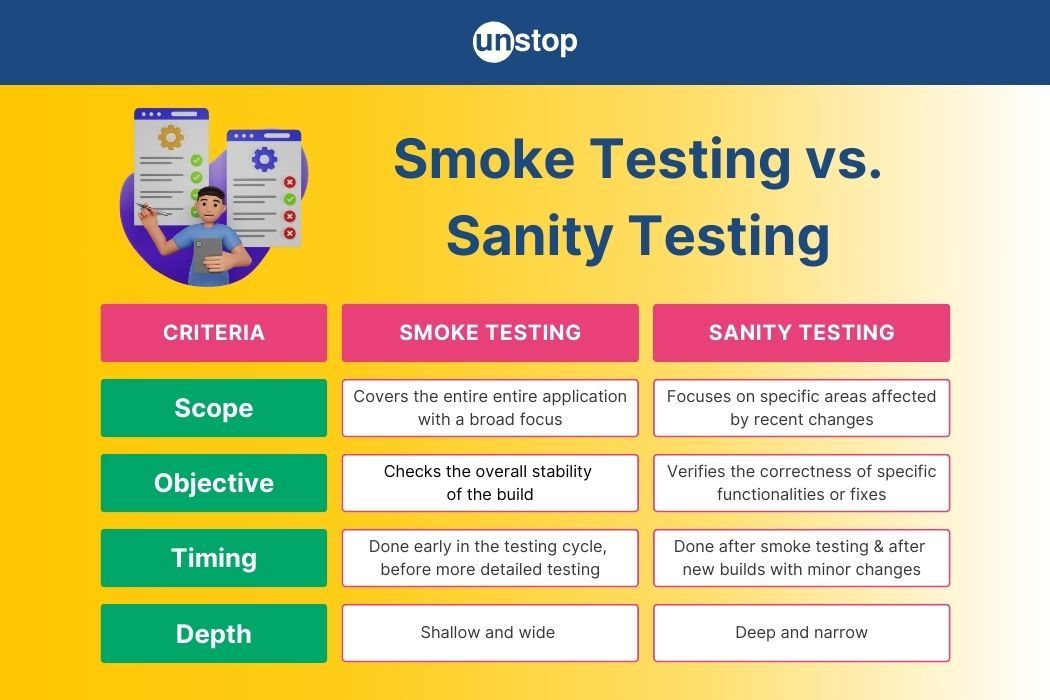
Testing is an important process in software development that evaluates a system's functionalities and performance to detect potential errors or bugs. It ensures that the final product meets the desired specifications, works as intended, and provides an optimal user experience.
Smoke and sanity testing are two types of initial tests performed during software development.
- Smoke testing is a preliminary check to verify if the build is stable enough for further testing. It's a superficial test covering the basic functionalities of the application or system. Think of it as a quick health check to determine if the product is "alive" or "dead."
- Sanity testing, on the other hand, is a more focused evaluation of specific functionalities or components after a code change. It's like a deeper dive into specific areas to ensure they work as expected.
Core Difference Between Smoke and Sanity Testing
There are various types of testing in software development, such as functional testing, regression testing, performance testing, and more. Each type serves a specific purpose and is used at different stages of the development process.
The focus of this article is specifically on smoke testing and sanity testing. These two types fall under the initial tests performed early in the development cycle to ensure a basic level of testing software quality before proceeding with further tests.
In essence:
- Smoke testing: Broad, shallow check of the entire application.
- Sanity testing: Deeper, focused check of specific functionalities.
Smoke testing and sanity testing are often confused, but they serve distinct purposes in the software development lifecycle. Let's clear the smoke and shed light on the sanity of these testing types.
Also Read: Important Software Testing Interview Questions
What is Smoke Testing?
Definition:
Smoke testing is a type of software testing that involves quickly and superficially reviewing a software application's main functionality to confirm that it can perform its basic functions without major errors or crashes.
It is usually performed at the beginning of the software development cycle to detect critical function issues early on.
The term 'smoke' refers to a quick check done to see any signs of fire before proceeding with a more detailed inspection. Similarly, smoke testing checks for significant problems or roadblocks that may affect further progress in developing or using the software product.
During smoke tests, testers will execute only basic features such as installing, launching, logging into accounts/accounts-related activities (e.g., sign-up), database connections/activities like saving data, among others, just enough amount required by their specification document.
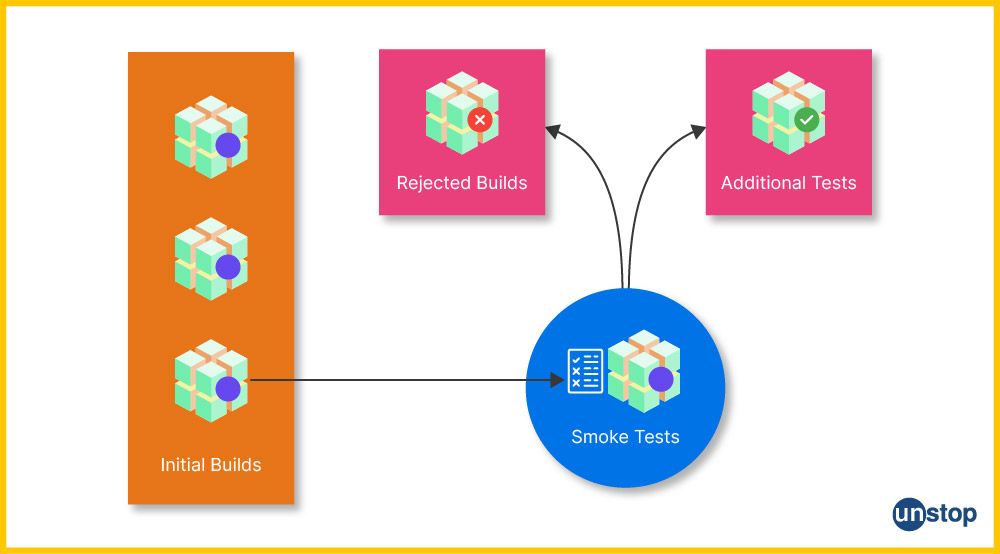
Key elements of smoke tests:
- Test cases: A set number of predefined scenarios are executed manually for each tested feature.
- Test environment: The test environment should mimic the real-life conditions in which the application for testing will be used.
- Basic functionality: Only critical functionality and core features are tested, only considering some possible input variations or scenarios. This is because smoke testing is meant to give an overall idea of whether a new build/version can proceed for further testing or if it needs more work before release.
- Interoperability with other systems: If external interfaces/systems such as databases or web services are involved, their connectivity and integration must also be checked during smoke tests.
Benefits of regular smoke testing:
- Early defect detection: Identifies critical issues before they escalate.
- Time and resource efficiency: Prevents wasted effort on detailed testing of a faulty build.
- Risk mitigation: Reduces the likelihood of product release delays due to major defects.
- Improved product quality: Ensures the core functionality of the software is consistently stable.
- Enhanced stakeholder confidence: Provides regular updates on the product's health and progress.
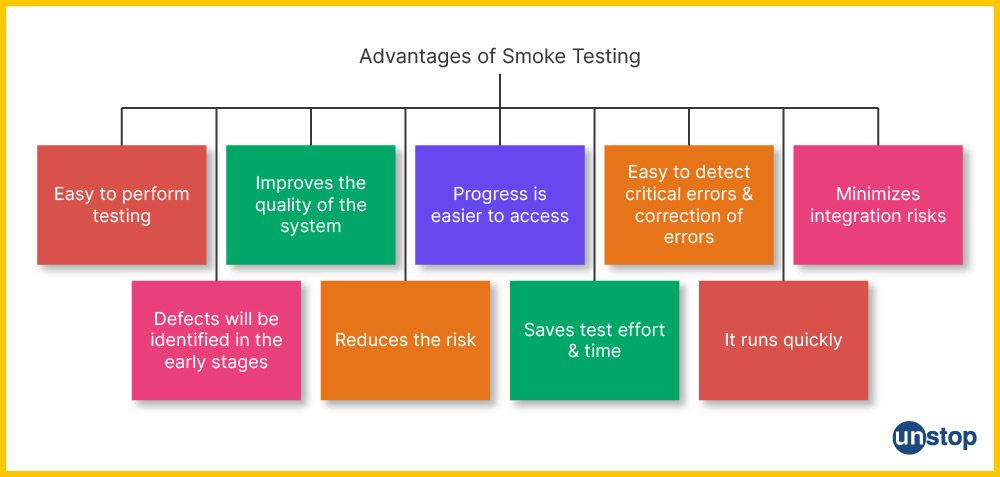
What is Sanity Testing?
Definition
Sanity testing verifies whether an application's core functions and features function properly after minor changes. It is a quick evaluation that determines whether further detailed and thorough testing is needed. This type of limited-scope test helps identify major defects early on before proceeding with comprehensive regression tests.
The term "sanity" refers to having a sound state of mind and rational thinking. Sanity testing, thus, tests whether the modifications or updates have affected the system's overall behavior in such a way that it becomes illogical and irrational for users.
During development cycles, small updates and fixes may be made frequently, resulting in unexpected system behavior. Due to their extensive nature, conducting full-scale regression tests every time these changes occur would be impractical. Sanity testing prevents the need for such exhausting testing.
Key characteristics of sanity tests:
- Quick checks with limited scope: Sanity tests involve minimal effort on behalf of testers to verify selected aspects of the software quickly. They are not highly detailed nor cover all scenarios; rather, these quick evaluations ensure that essential functionalities continue to work after implemented changes.
- Informal testing: Unlike other formalized tests, which require thorough documentation along with detailed test cases and scripts, sanity tests tend to be more informal, where results may not necessarily be captured but used for quicker decision-making instead.
- Manual execution: Unlike automated regression tests that include comprehensive test suites run by specialized tools like Selenium, sanity checks rely heavily on manual testing methods. Automation testing is often too impractical at this point because continuous code changes are frequently made during development cycles, making it difficult and inefficient for automation testing tool scripts to keep up with new functionality updates constantly.
Important: Sanity testing is not strictly ad hoc. While it can be performed unscripted, it's often based on a general understanding of the system and its functionalities. There's a degree of planning involved, even if it's informal. However, unlike regressions, which follow predefined test plans every time their target codebase is modified, there is no need for scheduled runs typically defined before releasing major versions or immediately after builds become available. To summarize, sanity testing is focused on specific areas, with a general plan but not a rigid script.
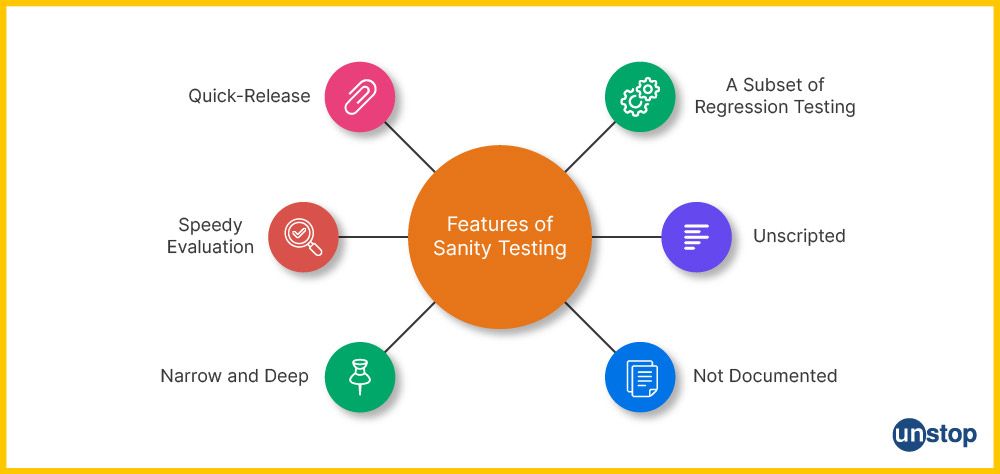
Advantages of Sanity Testing
- Rapid defect identification: Quickly uncovers major issues in core functionalities.
- Time and cost-effective: Less time-consuming and resource-intensive compared to extensive testing.
- Improved test efficiency: Prevents wasted effort on detailed testing of a faulty build.
- Risk mitigation: Helps prevent major issues from impacting later stages of development or deployment.
- Increased confidence: Provides assurance that the core application functions are working as expected.
- Facilitates further testing: Ensures a stable foundation for more in-depth testing.
Difference between Smoke and Sanity Testing
Smoke and sanity testing are types of software testing performed during different stages of the software development life cycle. They serve different purposes and have different characteristics.
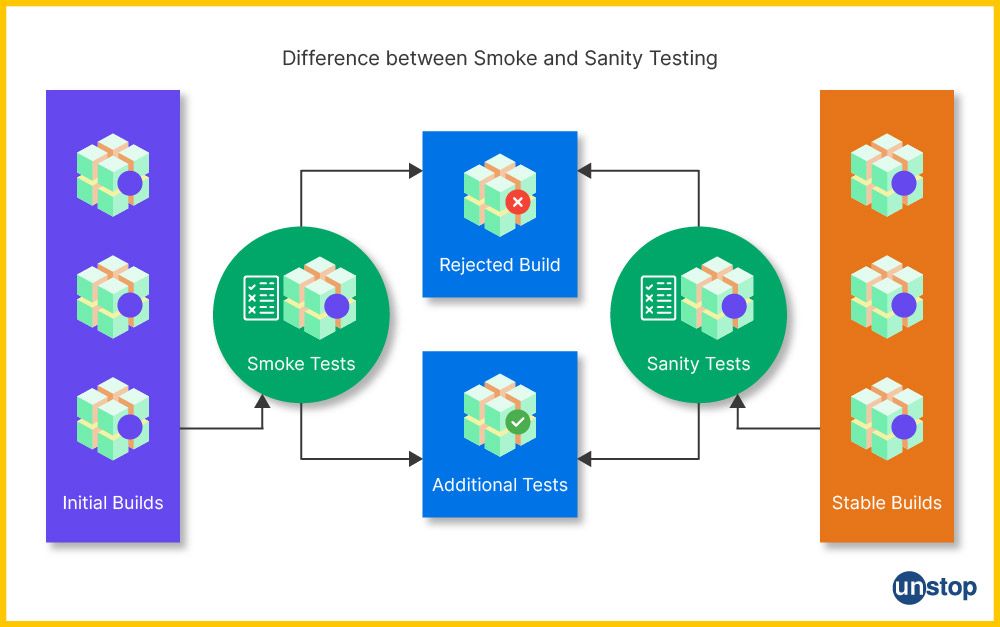
Key Differences: Smoke vs. Sanity Testing
Here is a comparison of smoke testing and sanity testing:
| Basis | Smoke Testing | Sanity Testing |
|---|---|---|
| Meaning | A basic check of an application's core functionality. | A focused test of specific functionalities after a code change. |
| Measures | System stability and basic functionality. | Functionality of specific features or components. |
| Technique | Primarily manual, but can be partially automated. | Can be manual or automated with simple test cases. |
| Execution | Testers and developers might be involved. | Primarily performed by testers. |
| Purpose | To identify critical issues and ensure basic functionality works. | To ensure core functionalities work as expected after changes. |
| Use | Often unplanned, quick checks before further testing. | Planned after code changes to verify specific areas. |
| Subset | Not directly a subset of another testing type. | Considered a subset of regression testing. |
Overall, this table provides a clear comparison of the two testing types, highlighting their differences in terms of scope, purpose, execution, and other relevant factors.
To sum it up, smoke testing aims to verify 'stability,' whereas sanity testing aims to verify 'rationality.'
Smoke Testing vs. Sanity Testing: Key Takeaways
- The software development testing process involves evaluating a system's functionalities and performance to detect potential errors or bugs.
- Smoke testing is an initial test that focuses on ensuring that an application's basic functions work without major issues.
- Sanity testing, also known as 'smoke tests,' verifies specific areas or features within the software according to predetermined criteria.
- Both smoke and sanity tests are performed early in the development cycle to identify critical defects before proceeding with further tests.
- Smoke tests involve executing only core features, while sanity tests verify modifications made during development.
- These types of testing help save time, effort, and costs by catching severe problems early on before they become more complex issues later in development.
- Regularly conducting these initial checks also provides feedback about progress and overall system stability.
- Smoke testing is also called by various other terms, such as Build Verification Testing (BVT), Confidence Testing, and Initial Checkout.
- Sanity tests are sometimes called User Acceptance Testing (UAT), Business Validation Tests or Production Verification Tests.
- The key differences between them include their scope, execution method, and involvement of teams/developers in the process.
Frequently Asked Questions (FAQs)
Smoke testing and sanity testing are two types of software testing techniques used to ensure that a software application is functioning correctly. Here are some of the most common FAQs about the differences between smoke and sanity testing:
1. What is smoke testing?
Smoke Testing is a preliminary testing technique used to check the basic functionality of a software build. It ensures that the most critical functions of an application work correctly before more in-depth testing is conducted.
2. What is sanity testing?
Sanity Testing is a type of testing performed after receiving a software build to check that the newly added functionalities or bug fixes work as expected. It ensures that the changes or fixes have not adversely affected the existing functionalities.
3. When is smoke testing performed?
Smoke testing is typically performed after a new software build is created and before any detailed functional or regression testing. It is a "build verification" test.
4. When is sanity testing performed?
Sanity testing is performed after receiving a software build with minor changes or bug fixes. It verifies that the specific issues have been resolved and that no further major issues have been introduced.
5. What is the primary purpose of smoke testing?
The primary purpose of smoke testing is to ensure that the major functionalities of the application are working correctly and that the build is stable enough for further, more detailed testing.
6. What is the primary purpose of sanity testing?
The primary purpose of sanity testing is to verify that the specific functionality or bug fixes in the application are working correctly and have not affected other parts of the application.
7. How detailed are smoke and sanity tests?
Smoke testing is broad and shallow, covering the critical functionalities of the application but not going into detailed testing of each feature.
Sanity testing is narrow and deep, focusing on specific areas of the application where changes or fixes have been made.
8. Who performs smoke and sanity testing?
Developers or testers can perform both smoke and sanity testing. However, testers more commonly perform smoke testing as part of the build verification process, while developers often perform sanity testing to ensure their changes have not broken existing functionality.
9. How long does smoke testing take?
Smoke testing is usually quick and can be completed in a short amount of time, typically ranging from a few minutes to a couple of hours, depending on the complexity of the application.
10. How long does sanity testing take?
Sanity testing also takes a relatively short amount of time, but it can vary depending on the scope of the changes or fixes being verified. It typically ranges from a few minutes to a few hours.
11. Can smoke and sanity testing be automated?
Yes, both smoke and sanity testing can be automated. Automated smoke tests are often included in the continuous integration (CI) pipeline to quickly verify the stability of new builds. Sanity tests can also be automated to verify specific functionalities or fixes.
12. What are the key differences between smoke and sanity testing?
- Scope: Smoke testing covers the entire application with a broad focus, while sanity testing focuses on specific areas affected by recent changes.
- Objective: Smoke testing checks the overall stability of the build, whereas sanity testing verifies the correctness of specific functionalities or fixes.
- Timing: Smoke testing is done early in the testing cycle, before more detailed testing. Sanity testing is done after smoke testing and after receiving new builds with minor changes.
- Depth: Smoke testing is shallow and wide, while sanity testing is deep and narrow.
13. Can smoke and sanity testing be done together?
Yes, smoke and sanity testing can be done together as part of the overall testing strategy. Smoke testing ensures that the build is stable enough for further testing, and sanity testing ensures that specific changes or fixes have been correctly implemented without affecting other parts of the application.
Suggested Reads:
I’m a reader first and a writer second, constantly diving into the world of content. If I’m not writing or reading, I like watching movies and dreaming of a life by the beach.
Login to continue reading
And access exclusive content, personalized recommendations, and career-boosting opportunities.
Subscribe
to our newsletter
















Comments
Add comment